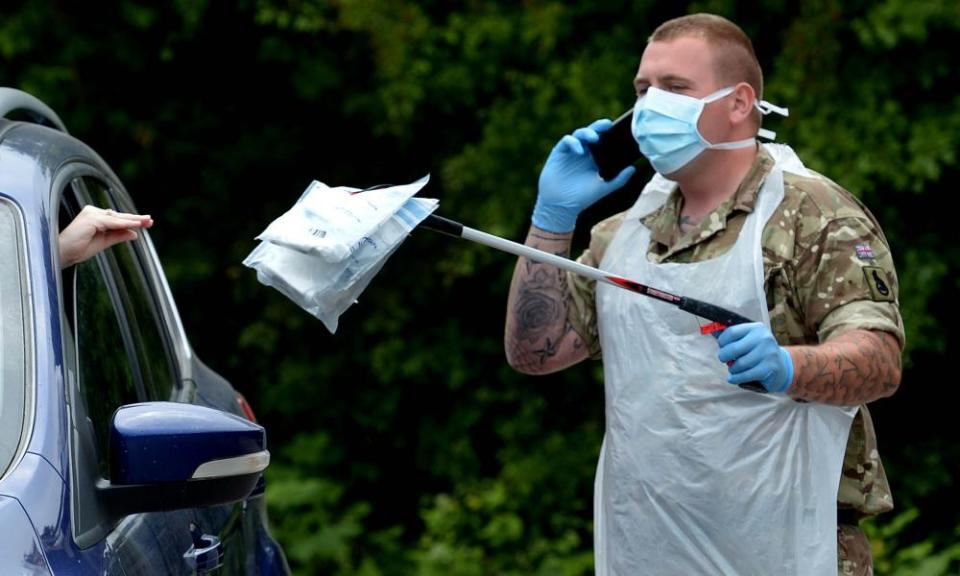Experts told UK to boost test-and-trace in February, papers show

The government was advised to scale up its coronavirus test-and-trace effort using a call centre system as early as February, government documents show, raising questions about why the system launched last week as lockdown measures were eased is still not fully operational.
A report presented to the government’s Scientific Advisory Group for Emergencies (Sage) on 12 February, when the UK was still actively tracing contacts of those infected with Covid-19, recommended a 10-fold increase in Public Health England’s test-and-trace capacity in order to extend the number of cases that could be managed.
“Scaling this response up, using for example a call-centre type system to support the local PHE teams, should be possible and feasible,” the experts from Public Health England and the University of Cambridge recommended.
However, this suggestion did not appear to be pursued and contact tracing was abandoned in March.
The PHE experts also concluded that contact tracing would become potentially unsustainable when the number of infections resulted in more than 8,000 contacts needing to be traced each day, and recommended that the operation should be wound down at that stage. Tracking down all the contacts of an infected person would have been more challenging at that stage in the epidemic, because numbers were rising rapidly, and widespread social distancing did not come into place until the lockdown on 23 March.
The latest tranche of documents published by Sage, which cover advice given by its subgroups on public health, reveal that the government was also repeatedly alerted to the risk of spreading infections from hospitals to care homes.
A document, from 24 February, considering the case of a hospital outbreak, recommends that there should be “no discharges to care or residential homes” under these circumstances and that other patients who are fit to be discharged should be required to isolate at home in order to prevent onward spread in the community.
On 13 April, the New and Emerging Respiratory Virus Threats Advisory Group (Nervtag) warned that “particular caution should be exercised in Covid-19 patients discharged from hospital to nursing homes, homeless shelters, or other institutions where there are vulnerable individuals”.
About 16,000 UK care home residents are believed to have died from Covid-19 in outbreaks that have struck 38% of care homes in England and 59% in Scotland. And infections spilling over from care homes and hospitals into the community are continuing to be a significant driver for new cases across the country.
Government advisers also highlighted the potentially limited effectiveness of the proposed NHS test-and-trace app, at a time when it was being heralded as a key component of safely lifting lockdown.
One paper points out that an app would potentially require people with only a 5% chance of infection to quarantine, and that the requirement of around 75% of the population to download the app to make it highly effective would mean it would need to become the most popular user-installed app, ahead of Facebook and with triple the popularity of the most popular Android game.
The documents also give some insights into the advice the government was receiving on the widespread use of face masks, which was previously advised against, before the transport secretary, Grant Shapps, announced on Thursday that face coverings will be compulsory on public transport from 15 June. A document, from 13 April, recommends that there is insufficient evidence to support the universal use of masks in the community, warning of the possible “significant impact on the ability of the NHS to purchase sufficient masks for health care workers”.
Other documents show that experts considered whether to recommend a 1m versus 2m rule for social distancing, and concluded that since transmission at distances of above 1m are known to be possible, “1 metre is a minimum, 2 metres is precautionary” and that “there is no entirely safe minimum duration” for contact with an infected person, but that 15 minutes was a pragmatic threshold for the purposes of contact tracing.
Curbs on travel into the UK were also considered on 22nd March, but experts advised this would have a “negligible impact” on the outbreak given widespread transmission in the UK.
“This might change if the UK were to successfully contain the epidemic,” one document reports.
Despite relatively high numbers of infections continuing in the UK, rules announced in May revealed passengers arriving in the UK by plane, ferry or train will have to quarantine for 14 days.
The documents are the latest to be released after No 10 came under pressure to publish the membership of Sage and the advice it has provided to ministers. In April, the Guardian revealed that Cummings, the prime minister’s senior aide, had participated in Sage meetings.

 Yahoo Finance
Yahoo Finance 